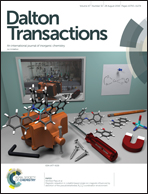Controlled synthesis of up-conversion luminescent Gd/Tm-MOFs for pH-responsive drug delivery and UCL/MRI dual-modal imaging†
Abstract
Using a facile one-step hydrothermal method, a series of metal–organic frameworks containing Gd/Tm (Gd/Tm-MOFs) were prepared successfully. Through the mutual activation of Gd3+ and Tm3+, Gd/Tm-MOFs showed unexpected excellent up-conversion luminescence (UCL) and a superior positive magnetic resonance image (MRI). Using doxorubicin hydrochloride (DOX) as a drug model, the feasibility of Gd/Tm-MOFs as a multifunctional drug carrier was demonstrated. Through modifying Gd/Tm-MOFs with uniform mesoporous silica (mSiO2) shells and folic acid (FA), the drug loading was improved up to 41.5 mg g−1, and pH responsive drug release increased to 64% from 12% by regulating the pH from 5.8 to 7.4. Also, the particles were tracked by MRI, and the second highest longitudinal relaxivity (r1) among the reported gadolinium complexes of 225.86 mM−1 s−1 was achieved. The cell imaging shows obvious blue and red luminescence under 980 nm laser excitation, and the up-conversion luminescence is unique because there is no autofluorescence from cells under 980 nm excitation. This indicates their promising application in the biological field. All the experiments indicate the promising application of Gd/Tm-MOFs in diagnosis and treatment.



 Please wait while we load your content...
Please wait while we load your content...
